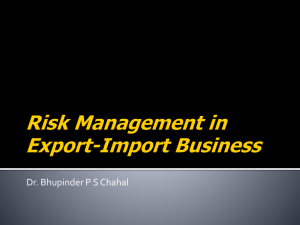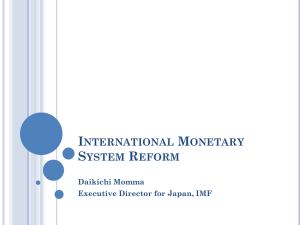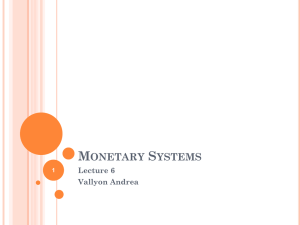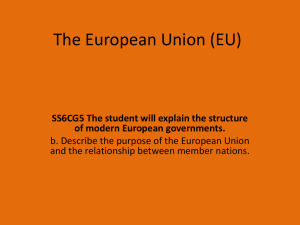Hot Money Flows and Currency Wars
advertisement
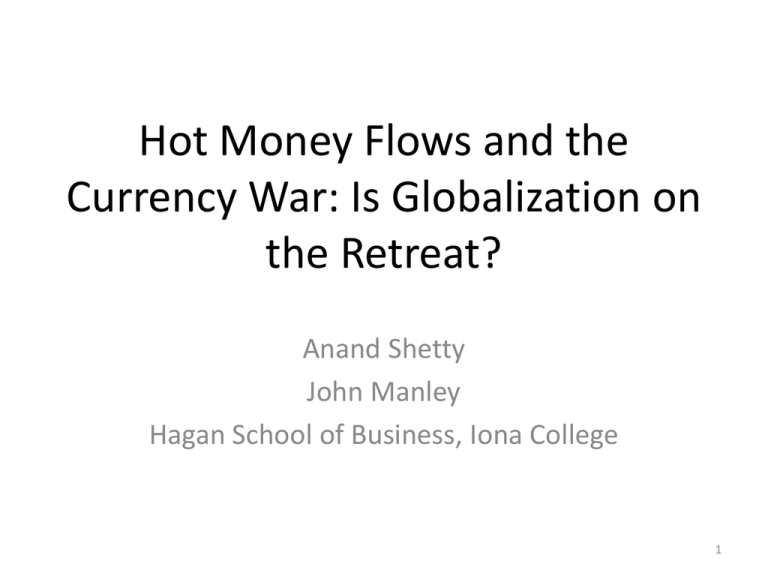
Hot Money Flows and the Currency War: Is Globalization on the Retreat? Anand Shetty John Manley Hagan School of Business, Iona College 1 Hot Money Flows and the Currency War • After a short pause following the 2010, the global currency war is back in full force in 2011. • The Major Cause: the global imbalance – Saver Nations versus Consumer Nations • The main contributors: – Continued economic weakness in the major developed economies in the west – Escalating European sovereign debt problem 2 Hot Money Flows and the Currency War • During the financial crisis of 2008-09, “Great Recession,” China & other emerging countries played a key role in preventing a major global collapse • Emerging States maintained their economic growth, supporting the exports of the developed countries like the U.S. and preventing a deeper recession • The western world came out of this recession in much worse shape than emerging powers. 3 Hot Money Flows and the Currency War • With the U.S. unemployment hovering at 10 % • the European Union facing the sovereign debt crisis, • Western economic recovery continued to be illusive. • Policies undertaken to deal with these problems left the interest rates in the west at the lowest level seen in recent years and drove their currencies values low 4 11/3/2011 9/3/2011 7/3/2011 5/3/2011 3/3/2011 1/3/2011 11/3/2010 9/3/2010 7/3/2010 5/3/2010 3/3/2010 1/3/2010 11/3/2009 9/3/2009 7/3/2009 5/3/2009 3/3/2009 1/3/2009 11/3/2008 9/3/2008 7/3/2008 5/3/2008 3/3/2008 1/3/2008 11/3/2007 9/3/2007 7/3/2007 5/3/2007 3/3/2007 1/3/2007 Interest Rates 16 14 12 10 Real 8 Yen CHF 6 USD GBP 4 Euro 2 0 Source: Pacific exchange rate service Trading economies.com 5 Source: Pacific exchange rate service Trading economies.com Nov-11 Sep-11 Jul-11 May-11 Mar-11 Jan-11 Nov-10 Sep-10 Jul-10 May-10 Mar-10 Jan-10 Nov-09 Sep-09 Jul-09 May-09 Mar-09 Jan-09 Nov-08 Sep-08 Jul-08 May-08 Mar-08 Jan-08 Nov-07 Sep-07 Jul-07 May-07 Mar-07 Jan-07 Exchange Rate Index (Dollars/FC) 180 160 140 120 100 Real Yen 80 CHF Euro 60 SGD 40 20 0 6 Hot Money Flows and the Currency War • In an interconnected world, events and policies pursued in one country are transmitted quickly to other countries. • It could not have been more evident than what was observed during this financial crisis. 7 Hot Money Flows and the Currency War • Growing uncertainty created by European sovereign debt crisis and the battle between Republicans leaders and the U.S. President over the budget and the low yields in the west have driven investors to the perceived safety of currencies like yen and Swiss franc and to some high yield markets in the east and the south. 8 Hot Money Flows: Currency War • Hot Money: s-t funds seeking best rates • Hot money flows resulting from the easy money policies of the west became a major concern for its trading partners • With the exception of China, emerging nations where economic recovery has been strong were particularly concerned • Currency exchange values were high against dollar with dire consequences on their growth 9 Hot Money Flows: Currency War • Countries with strong economic growth generally experience upward pressure on inflation • to control inflation, they resort to tight monetary policy and a higher interest rate. • This, in turn, attracts capital (hot money). • Such capital flows are essentially destabilizing contributing to greater credit flows, higher inflation and greater competitive disadvantage. • Countries receiving funds must respond with measures to protect their currencies from appreciation and to forestall the destabilizing effects. 10 Hot Money Flows: Currency War • As money poured into assets in the East and South, their stock markets reached multi-year high • The weakening dollar & increasing hot money flows led Asia’s biggest economies to influence their own exchange rates to protect exports and growth • When countries try to export a way out of trouble, an environment of competitive depreciation (currency war) is created. 11 11/1/2011 9/1/2011 7/1/2011 5/1/2011 3/1/2011 1/1/2011 11/1/2010 9/1/2010 7/1/2010 5/1/2010 3/1/2010 1/1/2010 11/1/2009 9/1/2009 7/1/2009 5/1/2009 3/1/2009 1/1/2009 11/1/2008 9/1/2008 7/1/2008 5/1/2008 3/1/2008 1/1/2008 11/1/2007 9/1/2007 7/1/2007 5/1/2007 3/1/2007 1/1/2007 Stock Market Indices 250.00 200.00 150.00 Brazil Indonedia 100.00 Nzealand Singapore S.Africa 50.00 0.00 12 Hot Money Flows: Currency War • One interesting and rather troubling aspect of the weakening dollar, the appreciating currency also appreciates against renminbi • China has a policy of “fixing” value with the USD • Imports from China are cheaper and exports from the other nation are more difficult to maintain. • Among the currencies most affected: Swiss franc, New Zealand dollar, Japanese yen, Brazilian real and Singaporean dollar. 13 Brazil’s Problems • Brazil was one of the emerging countries hit hard by the hot money flows. • Brazil’s rapid economic growth and a high real interest rate of nearly 6% (Nominal 12.5%) made its market a powerful draw for foreign investors starved of investment opportunities in developed markets. • Brazil has been a vocal critique of the easy money policies of the developed countries (US and UK). 14 Brazil’s Problems • Brazil’s finance minister, Guido Mantago, stated: part of Brazil’s growth is leaking overseas due to the sharp appreciation of the Real against the Dollar making exports less competitive and flooding the country with cheap imports. • The Real’s value against the US dollar jumped 48% between July 2009 and July 2011. • Brazilian real soared to a 12-year high against USD in July 2011, strongest level since it first floated in 1999 • The strength of real was further aided by the biggest monthly trade surplus in June 2011. 15 Nov-11 Sep-11 Jul-11 May-11 Mar-11 Jan-11 Nov-10 Sep-10 Jul-10 May-10 Mar-10 Jan-10 Nov-09 Sep-09 Jul-09 May-09 Mar-09 Jan-09 Nov-08 Sep-08 Jul-08 May-08 Mar-08 Jan-08 Nov-07 Sep-07 Jul-07 May-07 Mar-07 Jan-07 Exchange Rate Monthly Average USD/BRL 0.7 0.6 0.5 0.4 0.3 USD/BRL 0.2 0.1 0 Source: Pacific exchange rate service 16 Brazil’s Problems • To counter the effects of rising real, Brazil was forced to take actions due to a surge in imports from China which included – buying dollars – requiring banks to hold higher reserves against foreign exchange reserves – discouraging bets on dollar weakness, and – tax breaks and trade barriers to protect manufacturers hurt by currency appreciation 17 Currency War • Brazilian actions highlight the dilemma faced by other fast-growing economies including Turkey, Chile, Colombia and Russia. • Central banks have been desperately trying to stop destabilizing capital inflows. • Japan launched direct intervention, a move contemplated by Colombia, Thailand, Singapore, South Korea and Taiwan. • China, on other hand, stuck to its longstanding policy of pegging renminbi to USD. 18 Currency War • The defensive position staked out by the Swiss National Bank on the 6th of September, 2011 is another indication of this growing tension. • The franc had “overvalued” by 35% in real terms threatening to push the Swiss economy into a very deep recession when the SNB took action. • The SNB said it would set a minimum exchange rate of SF1.20 against euro. (As China, fixing value.) 19 Currency War • Some Central Banks resorted to less direct action by resorting to slower monetary tightening than they would otherwise do. • Bank of Canada and Reserve Bank of Australia, for example, have taken a precautionary pause in its tightening cycle, not resorting to currency market action. 20 Concluding Observations • The current problem of hot money flows and currency wars is rooted in global imbalance • A coordinated plan by major economies is needed to ensure a balanced global economic growth • Efforts of G20 has been less than satisfactory. • Japan’s intervention in the currency markets to weaken the yen days before the Cannes summit of G20 in November 2011 is an indication of the fact that the G20 is either incapable or too slow to act 21 Concluding Observations • Individual countries role in a coordinated policy action is rather demanding one. • What might work for one country, may not work well for everyone else. • FED fighting to prevent recession with easy money policy when no assistance is coming forth from politically paralyzed Congress. • European Union is hamstrung with the sovereign debt problems and looming recession and has not been able to do much to help the global recovery. 22 Concluding Observations • These recent national actions to protect their currencies has reawakened interest in how to manage destabilizing capital flows. • IMF suggests that the world needs rules to govern the imposition of capital controls. • At G20 meetings, there is reluctance to criticize China for holding down the renminbi which threatens developing country manufacturers with loss of competitiveness. 23 Concluding Observations • Lack of willingness on the part of China to change its exchange rate policy in spite of repeated threat of legislative action by the U.S. and the retaliatory actions taken by some by imposing restrictions on movements of goods and capital will only perpetuate the current environment of economic instability and market uncertainty. • What is notable about all this is that world organizations such as G7 and G20 have been unable to do much about the problem 24 Concluding Observations • Globalization that prospered during the period of strong performance by major economic power stands threatened under the current environment of: – lagging economic growth in the west, – mercantilist policies of countries like China, and – barriers to the free flow of goods and capital brought about by the currency war. 25 Current Recommendations • Removing dependence on U.S. dollar as a reserve currency has been mooted. – China and Russia have been vocal about their desire to reduce reliance on the dollar. – China has moved in the direction of renminbi-based trade settlements with some of its partners. – At BRICS summit, Republic of South Africa stated a transition [time-line unknown] to mutual payments in national currencies to avoid USD. • It is difficult to visualize, however, how this would solve the root problem of global imbalance. 26 Current Recommendations • Two other alternatives to the reserve currency problem – Return to the gold standard, and – an increased role for special drawing rights (SDR). • The second one makes more sense than the first as the history of the gold standard is not a particularly good one 27 Concluding Observations • A disturbing prediction for the world – unless countries join together to pursue coordinated policy to solve the global imbalance, – currency wars and trade restrictions will continue, – world economy will remain unstable with continued financial market uncertainty and global crises. • What is needed is a set of prudential not retaliatory policies on the part of each country even if it is inconvenient for the moment. • Ultimate solution: resolve the issue of global imbalance 28 Mahalo: Aloha Sample Pictures.lnk 29



